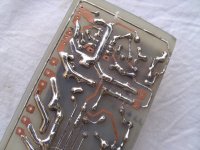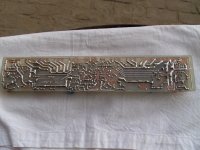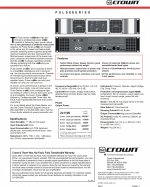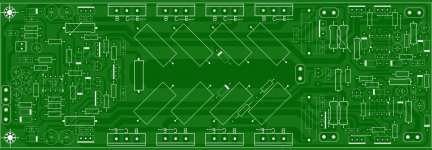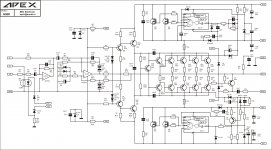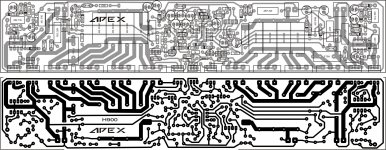I agree about QSC.QSC rmx/plx/pl/isa/mx series have emitters connected to step switch rather than collectors still they work nicely.🙂
TL072 work good in Crown, and will work in any STABLE complementary BJT amp.Class-H is nothing except a class-ab amplifier with rail step switching.😉
The TL-072 switching has some serious flaws in driver turn-off, also the slew rate of that opamp configured as comparator is not adequate, instead use IR2117 circuit.
hi apexaudio
greetings posted pics of board have to smoothen solder tracks
put solder to strenghten current capability have to put strong jumpers around
irf 2807 checking for solder shorts will then clean pcb
thanking you
andrew lebon
greetings posted pics of board have to smoothen solder tracks
put solder to strenghten current capability have to put strong jumpers around
irf 2807 checking for solder shorts will then clean pcb
thanking you
andrew lebon
Attachments
QSC rmx/plx/pl/isa/mx series have emitters connected to step switch rather than collectors still they work nicely.🙂
Doing that is all about limiting the gain the the output stage. You just can't run outputs open loop, switch them, and expect stability. The in Original QSC circuit, the output CFP's are configured as FOLLOWERS, and there are only two stages of current gain. (Do this with three, and you must go to triple EF. Don't just take my word for it - try it, build an oscillator/bomb, and then post the results.)The output section appears to have "gain", but only by virtue of the op amp, which is itself unity gain stable. The newer PLX circuit's output section has local feedback, with a gain of less than 20 with the rest provided by an op-amp. The PLX circuit actually sounds better than the original in practice - but I wouldn't expect the first PCB layout you try to work. And it requires very careful adjustment of the bias for thermal stability. These circuits have been simulated to death and have been refined over 20+ years. The powerlights don't all use the same approach - the new ones are class D.
TL072 work good in Crown, and will work in any STABLE complementary BJT amp.
He's just saying that 13V/us isn't fast enough. With low frequency signal it is - at 20 KHz you want something faster. About 30-50V/us is what is really needed to keep switching losses reasonable. The QSC switches the rail in about 1us. If you use the IR2117, you can get that down to 50ns. But I wouldn't. Even class D is a challenge at those rates, and requires many passes of layout work before it's reliable.
If anyone wants to
Try Class-H on Quasi-complementary mosfets then go for grounded bridge topology and use a monorail switch at high side, then only one unipolar switching will be needed.😉
can you provide schematic for this ?
Switching losses are resonable with TL072, but mosfet need cooling by heatsink. With IR2117 mosfet can work without heatsink, but no need to risk. I suggest circuit with TL072 just in case IR2117 is not available.He's just saying that 13V/us isn't fast enough. With low frequency signal it is - at 20 KHz you want something faster. About 30-50V/us is what is really needed to keep switching losses reasonable. The QSC switches the rail in about 1us. If you use the IR2117, you can get that down to 50ns. But I wouldn't. Even class D is a challenge at those rates, and requires many passes of layout work before it's reliable.
Last edited:
S-C1100 pulse 2x1100W 4R, 2x1900W 2R, 2x750W 8R
Hello
I don't know this Crown model, it's not on Crown web site, where can we find it's schematic diagram ?
Btw, TL072 op-amp are a bit slow, how about a much faster one ?
IR2117 is not available here arround, so an op-amp seem a good solution..
Thank
Bye
Gaetan
crown pulse 2x1100
Hello
I don't know this Crown model, it's not on Crown web site, where can we find it's schematic diagram ?
Btw, TL072 op-amp are a bit slow, how about a much faster one ?
IR2117 is not available here arround, so an op-amp seem a good solution..
Thank
Bye
Gaetan
Attachments
I have been thinking about this myself & then thought why bother with an op amp... With a tiny bit of modification the TL072 circuit could be modified to use a dual comparator such as the LM319 (yes, i know it has open collector outputs which is why i said a little modification) with response times of less than 80ns.Btw, TL072 op-amp are a bit slow, how about a much faster one ?
IR2117 is not available here arround, so an op-amp seem a good solution..
They appear to be nice & cheap to 🙂
Hello
I've look at the crownaudio web site for that Pulse Serie amp and I've found the schematic.
Here it is for those who want to see it:
http://www.crownaudio.com/pdf/legacy/s-c1100as-03.pdf
Thank
Bye
Gaetan
I've look at the crownaudio web site for that Pulse Serie amp and I've found the schematic.
Here it is for those who want to see it:
http://www.crownaudio.com/pdf/legacy/s-c1100as-03.pdf
Thank
Bye
Gaetan
Do not bother at all, use TL072 😉I have been thinking about this myself & then thought why bother with an op amp... With a tiny bit of modification the TL072 circuit could be modified to use a dual comparator such as the LM319 (yes, i know it has open collector outputs which is why i said a little modification) with response times of less than 80ns.
They appear to be nice & cheap to 🙂
I'm not going to be building a PA amp though... If you look back to my earlier postings in this thread (which has been very helpful - thanks) you'll see i intend to build a cascode output stage & use schottky barriers to get rid of the problematic glitches at rail switching.Do not bother at all, use TL072 😉
Yes i could have gone class G but i'm a sort of skinflint & happened to have nearly everything i need to make 6 amplifiers class H style cascoded except for maybe a few transistors.
Class G would have involved me buying another 72 transistors + drivers (MJ15024 & MJ15025)... Not cheap, so i'm up for a challenge 😉
U can use discrete step driver without any IC, this is challenge. See Phonic XP3000 schematics.
Regards
Regards
Yes, i did think about that, but in reality maybe spending £6 for a few high speed comparators with a few other bits that i might already have is going to be simpler & cheaper (time wise to) than making some.U can use discrete step driver without any IC, this is challenge. See Phonic XP3000 schematics.
Regards
All the best 🙂
Mark.
Nice work, what size it is?a new version of PCB for this amplifier ,is not yet finalized, I'll be back with the final version for corrections
U not use limiter, and there is lot of mistakes which must be corrected, keep with good work.230 / 75 mm
I designed the PCB to be used in active subwoofers with built-in amplifier
Regards
- Home
- Amplifiers
- Solid State
- 900W H-class PA Amp with Limiter
